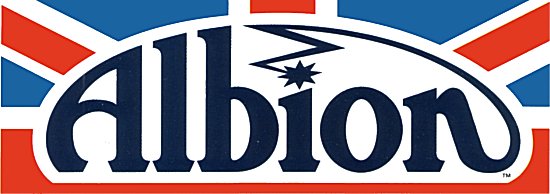
Albion Issue by Issue

Albion is an old name for England, with the backdrop being based on the colours and layout of the British flag, the Union Jack (more properly called the Union Flag).
Issue #1:
Cover
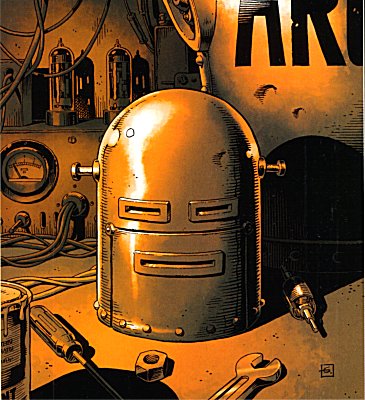
The cover depicts Robot Archie, apparently in a state of partial repair. Archie first appeared in Lion #1 on 23rd February 1952, and was one of the U.K.'s most enduring and iconic comic heroes, lasting in that title on and off for over twenty years. His adventures were reprinted in European titles, and he cameoed in early 2000 A.D.s (seen in the background of Tharg's Nerve Centre), and then guest starred in Zenith as Acid Archie (as recently as Prog 2000). An analogue of him turned up as Android Andy in Alan Moore and Alan Davis' Captain Britain strip in The Daredevils, and Jack Staff's Tom Tom the Robot Man looks to be at least partially inspired by him.
Given his condition inside, and that the series will see the revival of many British characters including him, his undergoing repairs on the cover is presumably a herald of things to come.
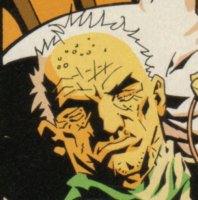 Page
1: Two unidentified guards or orderlies check some of the patients in
the superhuman prison. The man shown in each panel on this page is known
to me, but out of deference to those who don't wish to be spoiled, I'll leave
off identifying him until the next issue comes out. Suffice to say, he normally
has a lot less hair than in the pictures.
Page
1: Two unidentified guards or orderlies check some of the patients in
the superhuman prison. The man shown in each panel on this page is known
to me, but out of deference to those who don't wish to be spoiled, I'll leave
off identifying him until the next issue comes out. Suffice to say, he normally
has a lot less hair than in the pictures.
Panel 2: "That one gives me the creeps. Just watches you." - not enough to identify this one yet, but perhaps in an issue or two. Maybe Jason Hyde or X-Ray Specs?
Panel 4: "Looks like @%&*in' Ben Gunn" - Ben Gunn was the marooned pirate in Robert Louis Stevenson's Treasure Island, a non-comic book reference based on the character's unkempt growth of hair. Of course, he doesn't really have that much hair, but it is more than he used to have, back during his original appearances. More important is the @%&*in' - in British comics swearing was of course out of the question, as they were considered to be for children. So it was traditional to replace actual swear words with substitutes like the one used here. It's something which has largely fallen out of use nowadays, but perfectly in keeping with a title paying homage to the British comics of yesteryear.
Panel 5: We hear the name Eagleton, someone in authority in the prison. As yet, I'm unaware if this name has any hidden significance, as I don't recall any British comic character of that name.
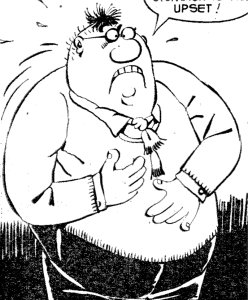
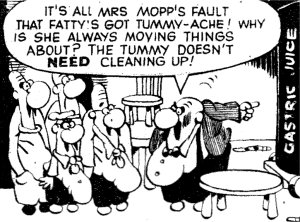
Panel 6: "And he's not got parasites living in him, either." "Aye, we're talking about you, you fat @%&*er". That'll be referring to The Nervs, microbes who lived and worked in Fatty in the Smash! strip named after them. Created by Leo Baxendale, they appeared in #1 to 162 of that title (5th February 1966 to 8th March 1969).
Panel 7: "Camp X-Ray" refers to the U.S. military base / internment centre in Guantanamo Bay, Cuba. Since groups such as Amnesty International have highlighted human rights abuses at Camp X-Ray, the reference here shows the custodians of these prisoners expect the American visitor to turn the prison into something equally bad.
Page 2
"No Future In England's Dreaming", the title of this issue's story, is one of the lines in the Sex Pistol's "God Save the Queen"
Our first sight of our hero Danny, who we later discover is Danny Doom all grown up.
"Charles Love Antiques" - not sure if this is a reference or not. There was a character called Charlie Peace, a "loveable rogue" who appeared in the Buster from 27th June 1964 to 15th June 1974, so this might be a nod to him. The real life Charlie Peace, on whom the comic character was based, was not so loveable.
"Mills and Boon" are the well-known series of British romance novels, while the novel in the window, The Spy Who Loved Me is, of course, one of the James Bond novels by Ian Fleming.
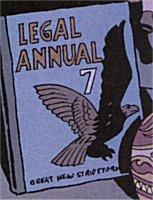 
In the window we can also see a copy of the "Legal Annual" - this refers to the Eagle comic, home of Dan Dare and many others - though the name is changed, the emblem of the Eagle (used today in the British Eagle Awards for comics) remains unmistakable. While most of the Eagle strips became and remain I.P.C. property, Dan Dare himself is not. Preview art for the issue showed the name Eagle Annual, so presumably a copyright issue arose, and the new name is both a pun on the original and on the legal issues which stopped that title being used.
|
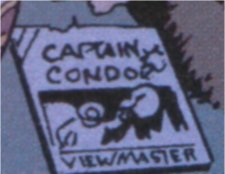
Captain Condor-Space Ship Pilot, who appeared in Lion, was a space adventurer (similar to Dan Dare) who adventured in 3000 A.D. Created by Frank S. Pepper, the hero first appeared in issue #1 of the comic (23rd February 1952), in a strip entitled Outlaw in Space, and continued to adventure in the title on into the 1960s.
Page 3
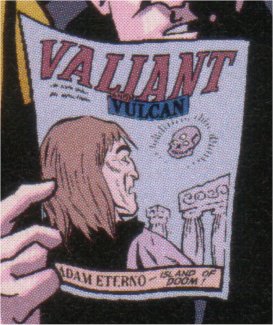 Panel
6: "This must be like, the last issue ever..."
Panel
6: "This must be like, the last issue ever..."
Vulcan was a British reprint title which launched 1st March 1975, collecting strips such as Mytek the Mighty; The Spider; Saber, King of the Jungle; The Rise and Fall of the Trigan Empire; The Steel Claw, Kelly's Eye, Robot Archie, The House of Dolmann, Raven on the Wing, and Billy's Boots. It later merged with the much older Valiant on 10th April 1976, to form Valiant and Vulcan, gaining (among other strips) Adam Eterno, who we see on this cover, though the story in question never appeared in a real world issue. Since it ceased weekly publication in 1976, we get Danny's comment "This must be like, the last ever..."
Page 4:
Panel 1: "The Incredible Adventures of Janus Stark" Stunningly drawn by Shane Oakley in the style of the original artist Solano Lopez, this is a new adventure of the Victorian escapologist and detective Janus Stark, who first appeared in Smash! on 15th March 1969. Apart from a few Summer Specials and Annuals, his last adventures were in Valiant in 1975. Given that the issue of Valiant and Vulcan Danny reads is from a year later, we might presume that the strip we are reading is one of Janus' last recorded adventures.
An analogue of his, Charles Raven, recently appeared in Jack Staff.
Panel 2: Clearly mirroring what happened to the British characters of modern times in Albion, the Victorians tried to lock away all the unique or abnormal individuals in their society. Since this is a comic within a comic, this might have been the writer of the Janus Stark strip trying to subtly hint what was happening to the heroes of the "real" world. Inspector Bryant was Janus' uneasy ally in the original strip, who found it difficult to believe Janus was innocent of the crimes he investigated. It seems he eventually decided Janus was a villain, and so went along with locking him away. The hooded jailer is identified a few panels later.
Panel 3: "Lot of tricky customers, eh?" Other characters based in the Victorian era who theoretically might have been locked away include Spring-Heeled Jackson (a D.C. Thomson character, so we wouldn't see him on panel, but see the next panel comments), the Hotspur's Leaping Phantom (again, D.C. Thomson), and The Shadow from The Hurricane.
Panel 4: "they had terrible trouble with that Spring-Heeled chap". This is a reference to the original Victorian bogeyman, urban legend and Penny Dreadful character, Spring-Heeled Jack.
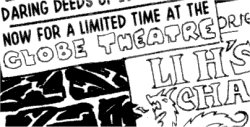 Panel
5: Two posters - the first states that Janus is doing his act at the Globe
Theatre, an interesting point because in the real world, the Globe was demolished
in 1644. It's foundations were discovered in 1989, and it was rebuilt, reopening
in 1997.
Panel
5: Two posters - the first states that Janus is doing his act at the Globe
Theatre, an interesting point because in the real world, the Globe was demolished
in 1644. It's foundations were discovered in 1989, and it was rebuilt, reopening
in 1997.
The second poster reads "...Orie...Li H'S.. Cha.." - this is a nod to the Doctor Who story Talons of Weng-Chiang (aired 26th February to 2nd April, 1977), and the full poster should read "Palace Theatre, Coronation Variety Company, Amazing Artistry, Li H'sen Chang, Master of Magic and Mesmerism" - the "Orie.." bit would say "Orient", but it isn't on the original poster seen in that television story. Date wise, the TV story referenced aired after this issue was meant to have been released (1977 vs. 1976), which is either a minor gaff, or a little hint that like the comics, the TV show Dr.Who was fictionalising real events.
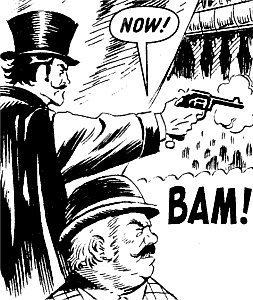
Panel 8: I don't recognise the man who fires on Janus off-hand. He's a somewhat stereotypical villian type, with top hat and twirly moustache, but I'd lay good odds he is a specific character.
Page 5
 Panel
2: I wonder if the two men who query if Janus being shot is all part of the
act are anyone of significance? If so, I don't recognise them.
Panel
2: I wonder if the two men who query if Janus being shot is all part of the
act are anyone of significance? If so, I don't recognise them.
Panel 4: "what with all that business in the East End..." - while this is probably a reference to the actions of the serial killer Jack the Ripper, it could also be referring to the murders committed by Weng Chiang in the aforementioned Dr.Who story, or the activities of Fu Manchu's Si Fan. Clearly the East End of London was not a safe place to be in Victorian times!
Panel 7: Naturally, the world's greatest escapologist has escaped.
Panel 8: When the jailor pulls down his hood, we see he is "The Elephant Man" (a.k.a. Joseph Casey Merrick). In the real world Merrick died in 1890, but depending on the date the Janus Stark story is set, here that might be a cover story designed to hide the fact he was actually illegally imprisoned.
Page 6:
Panel 2: "It was in the fifty pee box" For the non-U.K. readers, "fifty pee" is fifty pence, half a pound (£) - though the pound is stronger than the U.S. dollar, fifty pee can be considered akin to fifty cents, so you can understand why the shopkeeper makes the sarcastic comment about Danny's payment sorting out his mortgage.
|
 The design
on the rug is interesting - it looks vaguely familiar, though I'm not sure
where from. I think it might be something like the flag of the oppressive
Federation in British science-fiction show Blake's Seven, but I'm
really not sure.
The design
on the rug is interesting - it looks vaguely familiar, though I'm not sure
where from. I think it might be something like the flag of the oppressive
Federation in British science-fiction show Blake's Seven, but I'm
really not sure.
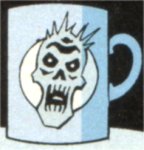
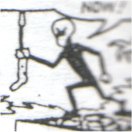 Page 7:
Page 7:
Panel 3: Not sure which character appears on this side of the mug yet. It might be Deathshead, foe of the Cloak, but it's hard to be sure.
Panel 6: Grymleigh Gartside Fiendstien, as Danny correctly deduces, was the villain who inspired the humour strip character Grimley Feendish. The "Rottenist Crook in the World" and his monsters started trying to take over the world in issue #1 of Smash! (5th February 1966), until #162 (8th March 1969). He also opposed Eagle-Eye, Junior Spy, another Leo Baxendale creation, over in Smash!s sister comic Wham!.
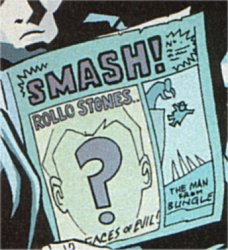 Panel 7:
Smash! was one of the "Power Comics" (alongside sister titles
Pow!, Fantastic, Wham! and Terrific). The first
issue came out on 3rd December 1966, published by Odhams Press. It
incorporated a couple of its sister titles (Pow! and
Fantastic), before Odhams was bought out by I.P.C. Magazines
and Smash! itself was absorbed into the more successful
Valiant. The cover mentions two of the title's strips:
Panel 7:
Smash! was one of the "Power Comics" (alongside sister titles
Pow!, Fantastic, Wham! and Terrific). The first
issue came out on 3rd December 1966, published by Odhams Press. It
incorporated a couple of its sister titles (Pow! and
Fantastic), before Odhams was bought out by I.P.C. Magazines
and Smash! itself was absorbed into the more successful
Valiant. The cover mentions two of the title's strips:
Rollo Stones, along with his partner Danny Charters,
were the Legend Testers, fortieth century explorers who would
travel back in their time machine to learn the truth about legends such as
King Arthur. They adventured in the title between issues #9 and 75 (2nd April
1966 to 8th July 1967)
The Man from B.U.N.G.L.E. (a.k.a. Larry) was a spoof on popular TV spy show, The Man from UNCLE, another Leo Baxendale creation who appeared between #4 and 136 (26th February 1966 to 7th September 1968).
Panels 8 and 9: Shane Oakley again reproduces the art style of the original artist, in this case Leo Baxendale.
Page 8
Panel 2: Don't know who the guy whose face is hidden in darkness is, but the prisoner serving food is Faceache (we get a close-up on the next page), the prisoner insulting him is Sylvester Turville, the other kitchen worker is Doctor Ratty Rat (a.k.a. The Rat) and I'm not sure about the final prisoner at this point.
The Rat was the villain in Scott Goodall's Rat-Trap, which ran in Cor!! from 1973. The self-proclaimed "King of Crime" was an enemy of B.I.F.F. (The British Institute for Foiling Felonies), who called on readers to devise traps to catch him. The Rat resurfaced in the 1980s incarnation of the Eagle comic.
Panel 3: We get a much better look at the Rat, as well as another large prisoner standing behind Faceache / Fred.
Panel 3: Two of the prisoners discuss the forthcoming visit. The one who mentuions everyone is jumpy can be identified by his name tag (visible in the next panel) as Louis Crandell, a.k.a. the Steel Claw, while his companion, whom he names Tim, is likely to be Tim Kelly.
Panel 6: In the foreground we have The Dwarf and the Toymaker (based on that distinctive haircut). Walking past holding a tray with a cup on it is another distinctive individual whom I can't identify yet (it's not the Spider, who we see on the last page in solitary).
Panel 7: Sylvester Turville walks past our conversational duo on his way to his seat.
Panel 8: Not sure who the guard is standing behind Turville.
Panel 9: As the Cloak walks past in the foreground, Turville tries to telekinetically steal the Dwarf's cake, leading to a violent confrontation on the next page.
Page 9:
Panel 4: An as yet-unidentified guard hauls the Dwarf off of Turville.
Panel 5: Another unidentified guard (with a drippy nose) sees to Turville while the first guard holds on to the grinning Dwarf.
Panel 6 (and 7, and 9 with nametag visible): Guard Blott, presumably one of the Swotts and Blotts who appeared in Smash!
Panels 7 and 8: The kitchen orderly, named Fred (short for Frederick,
presumably), was better known in his youth as
Faceache. DETAILS
Panel 9: Blott asks Fred to "do your Bruce Forsythe". Given his shapeshifting powers, imitating the British presenter and comedian Bruce Forsythe should be easy for him.
Page 10:
Panel 1: One of the crowd wears a track suit with the words "Le Chav" on it. A Chav is a derogatory name for a section of the British public characterised as wearing excessive cheap jewelry and cheap shell suits, acting like louts, drinking too heavily, and generally being uneducated and uncultured. Adding the French "le" prior to it gives it an air of ironic pretension, as our Chav tries to make himself seem more classy.
Panel 7: We are introduced to Penny, our heroine. She used to be Bad Penny, youthful delinquent who starred in Smash!.
Page 11:
Panel 3: Anthony Broke, whose name appears on the sign, is a reference to Tony Broke, one half of the duo Ivor Lott and Tony Broke, who appeared in DETAILS
Page 12:
Panel 1 and 2: Not sure which of the many girl school gangs this is, now all grown up. One, Alice, is named in Panel 6
Panel 3: Also unsure of the identity of their victim as yet.
Panel 7, 8 and 9: The Governor and his female guards. Again, so far I'm unable to say where they previously appeared.
Page 13:
Panel 1: On the far right in the yard, among all the junk, we can see a milk churn with the words "Grimsdale Dairy" on it. That's a reference to the 1965 British movie The Early Bird, where British comedian Norman Wisdom played Norman Pitkin, a milkman employed by Grimsdale's Dairy.
Page 14:
Panel 1: Just in case any Americans don't know the term, "D'you want a brew?" is asking if Danny wants a cup of tea.
Page 15:
Panel 1: HP Sauce, PG Tips, Tesco Pasta (Tesco), Heinz
Panel 2: "You plank", Pow!
Panel 4: Lion, Whizzer and Chips, Cor!!, Wham!
Panel 6: "Fab! Phone" - a reference to needing to phone the Fab Cafe, as seen later in the issue.
Panel 6 and 7: Chasing Comic Characters - Penny, a target herself, appears to have been trying to find out what happened to her fellow comic characters.
Page 16:
Panel 1: Lightning bolt on cup - Shazam?
Panel 2: Mike Higgs, creator of the Cloak, talks about how he put the jokes in the Cloak.
Panel 3: Phil Clarke -
CHANGE In 1967 Phil Clarke started KA-POW fanzine, a comic fan magazine with sales lists and a comic strip drawn by Mike Higgs. CHANGE
Over his shoulder we can see a sign "Do..Lawre... & Fra.. Hamp..." This refers to creators Don Lawrence and Frank Hampson (creator of Dan Dare)
Panel 4: "What about rumors that the Cloak was actually based on a real person?" We've already seen him a few pages back.
Page 17:
CHANGE Panel 1: “THE OFFICIAL SECRETS ACT”
The Official Secrets Act is a UK act of Parliament prohibiting the disclosure of confidential material from government sources by employees; it remains an absolute offence for a member or former member of the security and intelligence services (or those working closely with them) to disclose information about their work. CHANGE
Panel 3: “EVERYONE WHO WORKED AT ODHAM”
Odham Press published Eagle Comics (1950 – 1969, 1982 – 1993)
That's Steve Moore talking.
Panel 4: “CAPTAIN DARE”
Dan Dare (Colonel Daniel MacGregor Dare of the Interplanet Spacefleet) was created in 1950 by Frank Hampson. The sci-fi classic Dan Dare was originally published in EAGLE. Dan Dare fought his evil arch-nemesis The Mekon over many decades.
“DAN LLOYD WAS AN AASSISTANT EDITOR AT “FLYING SAUCER REVIEW””
Yes, he was, and the author of a number of articles, including “Things Are Hotting Up In The Arctic” for “Flying Saucer Review”, Vol. 11, No. 5. September-October 1965.)
Panel 5: “CAPTAIN HURRICANE”
Hercules Hurricane appeared in VALIANT (1962 - 1976), hewas the captain of a tramp steamer until his ship was sunk by a German U-Boat. He and his first mate, "Maggots" Malone, enlisted in the Royal Marine Commandoes, and took the fight back the Axis forces.
He also served as editor for Battle, so it makes sense he'd come into the office of the comics eventually.
Page 18
Panel 3: Key fob looks like “Frankie Stein”
Frankie Stein originally appeared in Wham! comic in 1964, and appeared in a number of different books until 1973.
Panel 8: Manchester. Currently the pair are in Liverpool (as stated on the TV several pages earlier, as that's where Feendish was being tried). Liverpool is.... Manchester is....
Page 19
Panel 5: The FAB Cafe, a real world pub with a science fiction theme.
Panel 6: Cult TV night - they really do hold these each week.
CHANGE Panel 7: Look like “Supercar” to me, which makes sense in a bar called “FAB Bar”
Supercar was a Gerry Anderson series (later creator of “Thunderbirds”), it was the first of the Supermarionation science fiction shows that he became famous for. Supermarionation was Anderson's term for the realistic style of puppetry he developed. The technique featured a cast of eighteen inch high marionettes that blinked, moved their eyes and seemed to speak.CHANGE
Page 20
Full Page Panel:
Cyberman, Robot Archie, Vampira ??
The Cybermen were created by Kit Pedler and Gerry Davis for the BBC science fiction program "Doctor Who", where they became one of the show's most popular monsters. Though the appearance of the Cybermen changed over the course of the show, for over twenty years they terrified school children throughout the world. Alan Moore contributed to Doctor Who Weekly Comic.
Robot Archie is described in the section dealing with the cover.
Don’t know if this is Vampira or not ??
Page 21
Panel 2: That school girl gang again
Panel 3: Their victim. Not sure what the little green thing is.
Panel 4: A flying female. I believe this is Justine, though her powers weren't originally innate.
Page 22: Panel 2 - Captain Hurricane?
Panel 2: “BIGGLES BIG ADVENTURE”
Biggles was created by W.E. Johns in 1932, Major James Bigglesworth started off as a fighter pilot in the Royal Flying Corps during World War I. Later stories told of Biggles' adventures after the War's end, his return to service in World War II, and further adventures in peace time. Johns continued writing Biggles short stories and novels up until his death in 1968; in all, nearly a hundred Biggles books were published.
This book title is not a real Biggles book, but is mentioned in UK SF TV show “Red Dwarf” in season three “Marooned”
Panel 3: Fishboy? or Kid Chameleon?
Panel 4: The Spider
Panel 7: “Strange Doors That We’d Never Close Again” – Next Month’s title are lyrics from David Bowie’s “Scary Monsters”
Any Additions/Corrections? Please let me know.
Back to General UK Comic Book Heroes.
All images and characters depicted are copyright their respective holders, and are used above for informational purposes only. No infringement is intended and copyrights remain at source.